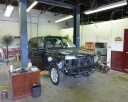Big Trucks, Big Dangers: Here are the Facts
Big Trucks, Big Dangers: Here are the Facts
Every time you’re out on the roads of this country, you encounter big trucks. They mostly motor along at a reasonable rate and they look harmless sitting in the slow lane. But, they also can be dangerous if you’re in the wrong place at the wrong time. At Rick's Auto Body & Collision Center, we’re all about safety, because we know that car accidents will happen, but by being proactive and vigilant, hopefully fatalities can be prevented.
Here are the facts:
- Most fatalities in large truck crashes are passenger vehicle occupants.
- Large trucks often weigh 20-30 times as much as passenger vehicles.
- Trucks are taller and have greater ground clearance than cars, which means that lower-riding vehicles can slide beneath truck trailers, with deadly consequences. Rear underride guards are supposed to stop this from occurring but research shows that guards meeting federal safety standards can fail in even low-speed crashes. Several agencies have petitioned regulators to require underride guards that are sturdy enough to remain in place during a crash and to expand rules to mandate guards for all large trucks and trailers.
- Truck driver fatigue is a huge concern, especially to drivers in passenger cars. Under federal hours-of-service regulations, drivers of large trucks are permitted to be behind the wheel for as long as 11 hours at a stretch. Surveys indicate that many drivers violate the regulations and work longer than permitted. Requiring electronic onboard recorders for all commercial trucks would improve compliance with federal work rules by automatically recording when a truck is driven. The recorders would replace the easily falsified handwritten logbooks drivers keep to catalog their work hours.
- Truck braking capability can be a factor in crashes. Compared with passenger vehicles, stopping distances for trucks are much longer, especially on wet and slippery roads or if the brake systems are poorly maintained. Large trucks also are prone to rolling over. A proposal to require truck tractors to be equipped with electronic stability control could help reduce crashes.
- On average, drivers of large trucks travel many more miles than passenger vehicle drivers, and a larger proportion of those miles are on interstates, which are the safest roads. In 2013, large trucks accounted for 4 percent of registered vehicles and 9 percent of vehicle miles traveled. Large trucks have a much lower rate per mile traveled of crashes resulting in nonfatal injuries or property damage only compared with passenger cars and light trucks.
Two U.S. Department of Transportation agencies and individual states administer large truck safety. The National Highway Traffic Safety Administration (NHTSA) sets standards for new truck equipment and has some jurisdiction over equipment standards for trucks currently on the road. The Federal Motor Carrier Safety Administration (FMCSA) oversees the safety of commercial vehicles in interstate commerce (vehicles operating across state lines) and has regulations concerning things such as equipment, licensing, hours of service, vehicle inspection and maintenance.
States regulate intrastate trucks (trucks operating only within a single state's borders), and state personnel conduct roadside inspections of trucks and drivers to enforce federal rules for equipment, hours of service and vehicle maintenance and inspection. Carriers with high rates of crashes and inspection violations are subject to interventions including warning letters, offsite investigations, onsite investigations and suspensions of service.
But, even with all of the oversight and regulations, big truck fatalities occur every day. So, the next time you encounter a few of these large 18-wheelers, be observant and wary and remember that caution should always be paramount. These helpful tips are brought to you by Rick's Auto Body & Collision Center , one of the finest collision repair companies in the state of VA.









Social